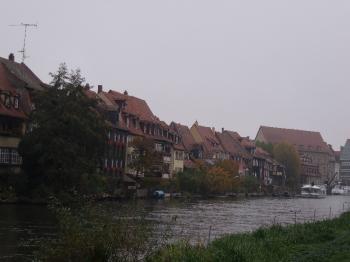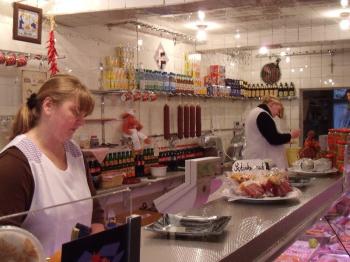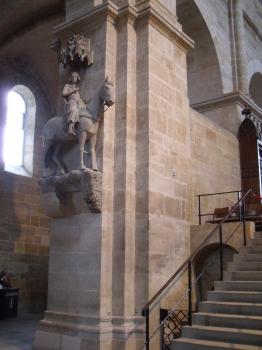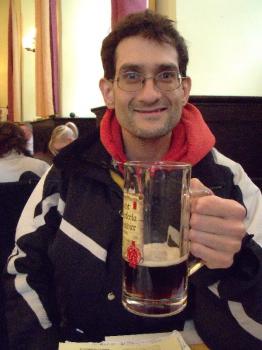Roy A. Barnes attended the German National Tourist Office’s “The Making of Christmas” press trip, in which he got to experience the following things discussed in the article. He freely wrote his impressions without any editorial scrutiny from the press trip sponsor.
Sometimes visiting a city is like being in a dreamstate, where fantasy seems to cohabitate with reality. That happened to me when I visited a Bavarian city that’s a 2 hour train ride from Frankfurt and that doesn’t always get mentioned in guidebooks on Germany, even though it’s been a UNESCO World Heritage Site since 1993. Yet for US servicemen, it’s a place that’s been voted as their favorite base several years running. I know why now.
A Sense of Déjà Vu

The first night and ensuing morning while taking my jogs in a city that has been described as “Franconian Rome” (because of its seven hills), I felt as if I knew what was going to be around every corner, experiencing a noticeable sense of déjà vu, even though in this lifetime, I’d never visited the city that’s been in some form of existence for the last 14 centuries.
I have often dreamed of wondering around the corridors of hospitals though I’ve not been in one as a patient since childhood. Well, I bunked down at the Hotel Residenzschloss, which once housed Europe’s first modern hospital, built in 1789 through the efforts of the benevolent Prince Franz Ludwig von Erthal. He really cared about his subjects, so much so that he even provided health insurance for those employed in trades. Now, the building features work tables longer than hospital beds and nightwatchmen who often stand guard at the entrance and entertain guests with guided tours. They make sure you don’t have to wander around directionless like I have in other dreams.
The Morning Jog in Misty Fog without Harassment from any Dog

My day with the world while on the road always starts with a jog. Jogging around the neighborhood of my hotel through a misty fog and my sense of déjà vu heightening, I first took notice of the city’s other Italian namesake “Little Venice”, where life size and multi-colored 14th through 18th century homes that look like dollhouses stand on tree poles even though you can’t see the tree poles. These dominated the canal front and their enchanted quality made me forget the autumn chill. I shared the streets and sidewalks with others hurriedly passing me by on bicycles (more ominous to runners here than cars) while others took a stroll with their unleashed dogs or babies in carriages. The untethered dogs, unlike in my hometown in Wyoming, actually left me alone.
After running and cleaning up, I ate a wonderful German breakfast full of whole grain breads and cereals plus fruit: so much for hospital food! That feast would give me the energy for my strolling around this mystical city with a population of a little more than 70,000.
A Legendary Stroll and German Practical!

I began a less hurried pace with some window shopping and taste testing in the city center, first visiting a butcher shop on Sandstrasse, where the friendly staff offered samples of a “revolutionary” spicy hot pork (that originated in 1776) called Leberkase plus their own recipe of semi-moist and sweet butterstollen. I spoke a few words from my German guidebook to a jovial regular customer eating a sandwich who was taking a break from his window washing duties.
As I headed toward the town square, my eyes often diverted upwards to see the four spires of Bamberg Cathedral in various states of fog shrouding it. It’s the first church that I ever heard of that may have been built partly by the devil, according to legend. The legend being where a young builder sold his soul to ol’ Mr. Scratch himself in order to outdo his older superior in the race to completion only to find that upon finishing the 13th century church, the young master was rewarded with Satan tossing him off one of the spires, as I understood my guide.
A fruit and vegetable market was well underway in the city center’s Bamberger Markt. Schoolchildren were on hand with pencil and paper rambunctiously doing an exercise identifying the nutritious items. I took notice of one kid who was wearing a traditional Bavarian hat called a trenker. He must’ve known that tourists were coming, and dressed for the occasion. The only missing from that scene was a black and tan dachshund.

I then headed across the River Regnitz, where right smack in the middle is another one of Bamberg’s most notable sights, the Altes Rathaus (Old City Hall), which proves the notion that when life gives you lemons, you make lemonade, according to another legend. In the late 14th century, the residents couldn’t get the Bishop of Bamberg to give them any land for building a town hall, so they decided to build it on the river. Oh, the Germans are ever so practical during consciousness! The first structure lasted until it was blown up in 1444. The rebuilt building I saw has exteriors in Baroque/Rococo fashion that were put there from 1744-1756. Right next to the oddity, I took a short Spezl (Coke + Fanta soft drink) break at an Italian gelateria that overlooks the river and rathaus to ponder my adventure so far in this enchanted city.
As I headed up to the foggy Bamberg Cathedral, I couldn’t help notice the little mom and pop shops along the way which were selling Christmas items and antiques. The latter really appeal to me, especially when trains, miniature soldiers and old paper money beckon from the window. The cathedral itself, standing proudly on one of the seven hills, contains the much heralded Der Bamberger Rider (Bamberg Horseman), which dates to around 1230. For centuries, it wasn’t known who the rider was. Now, it’s been pretty much narrowed down to Stephan of Hungary. Who created this work of art is still a mystery.
It’s Here Where I Drank Some Rauchbier

Bamberg is known for its 9 major breweries, and produces a smoked beer called Rauchbier, like the one served by the Schlenkerla Brewery and Malt House. Even though I’m not much of a drinker, I just had to try the local specialty after my church visit. When in Franconian Rome, do as the Franconian Romans do, which I did at a local dining establishment-pub down the hill from the cathedral called Hofbrau Restaurant & Bar. I really liked the smoky taste that went down smoothly and wasn’t that bitter. It went well with some goose liver dumplings with a German name so long on the menu, that even in my Bamberg dreamstate, I wouldn’t dare try to pronounce it or write it out asleep or awake.
All dreams must come to an end, as it did for me in Bamberg’s city center. But not before spending a little time and money in that quaint antique shop with the distracted shopkeeper. There were more places to see as the constraints of time became all too real. So I’m left with just memories of my sauntering through the mystical land of doll houses, where I could take a morning jog in misty fog, without harassment from any dog.
Bamberg Tourism Information: www.bamberg.info
Germany Tourism Information: www.cometogermany.com
Biography: Roy A. Barnes is a frequent contributor to Bootsnall.com, writing and dreaming in southeastern Wyoming when he’s not traveling.